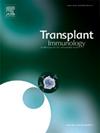Forty years of kidney transplantation: Insights into malignancies at a single center in Latin America
IF 1.6
4区 医学
Q4 IMMUNOLOGY
引用次数: 0
Abstract
Background
Kidney transplantation is the optimal therapy for end-stage kidney disease (ESKD), but lifelong immunosuppression increases malignancy risk, a major cause of mortality in transplant recipients. This study evaluates post-transplant malignancies in a kidney transplant cohort.
Methods
We conducted a retrospective analysis of 375 kidney transplant recipients at Hospital Las Higueras, Talcahuano (January 1981–July 2024). Demographics, clinical characteristics, and malignancy data were extracted from medical records.
Results
Of 375 patients, 33 (8.8 %) developed malignancies, with 27 % experiencing multiple cancers. While the mean age at transplantation was 51.5 years, the mean age of those developing a malignancy was 60.4 years. Non-melanoma skin cancers were most common (55.1 %), followed by solid organ cancers (26.5 %), chronic kidney disease (CKD)-related cancers (8.2 %), and hematologic malignancies (8.2 %). The mean time to malignancy onset was 106 months post-transplant. Cancer-related mortality was 30 %.
Conclusion
The high incidence of malignancies, particularly skin cancers, highlights the need for regular clinical and dermatologic surveillance in transplant recipients. Optimizing immunosuppression to balance rejection prevention and cancer risk, along with comprehensive cancer screening, is essential for improving long-term outcomes.

肾移植的四十年:拉丁美洲单一中心对恶性肿瘤的见解。
背景:肾移植是终末期肾病(ESKD)的最佳治疗方法,但终身免疫抑制增加了恶性肿瘤风险,这是移植受者死亡的主要原因。本研究评估肾移植队列移植后的恶性肿瘤。方法:回顾性分析1981年1月至2024年7月在塔尔卡瓦诺市Las Higueras医院接受肾移植的375例患者。从医疗记录中提取人口统计学、临床特征和恶性肿瘤数据。结果:在375例患者中,33例(8.8 %)发展为恶性肿瘤,27 %出现多发性肿瘤。移植时的平均年龄为51.5 岁,而发生恶性肿瘤的平均年龄为60.4 岁。非黑色素瘤皮肤癌最常见(55.1% %),其次是实体器官癌(26.5% %),慢性肾脏疾病(CKD)相关癌症(8.2% %)和血液恶性肿瘤(8.2% %)。移植后发生恶性肿瘤的平均时间为106 个月。癌症相关死亡率为30 %。结论:恶性肿瘤,特别是皮肤癌的高发病率,强调了对移植受者进行定期临床和皮肤病学监测的必要性。优化免疫抑制以平衡排斥预防和癌症风险,以及全面的癌症筛查,对于改善长期结果至关重要。
本文章由计算机程序翻译,如有差异,请以英文原文为准。
求助全文
约1分钟内获得全文
求助全文
来源期刊

Transplant immunology
医学-免疫学
CiteScore
2.10
自引率
13.30%
发文量
198
审稿时长
48 days
期刊介绍:
Transplant Immunology will publish up-to-date information on all aspects of the broad field it encompasses. The journal will be directed at (basic) scientists, tissue typers, transplant physicians and surgeons, and research and data on all immunological aspects of organ-, tissue- and (haematopoietic) stem cell transplantation are of potential interest to the readers of Transplant Immunology. Original papers, Review articles and Hypotheses will be considered for publication and submitted manuscripts will be rapidly peer-reviewed and published. They will be judged on the basis of scientific merit, originality, timeliness and quality.
 求助内容:
求助内容: 应助结果提醒方式:
应助结果提醒方式:


